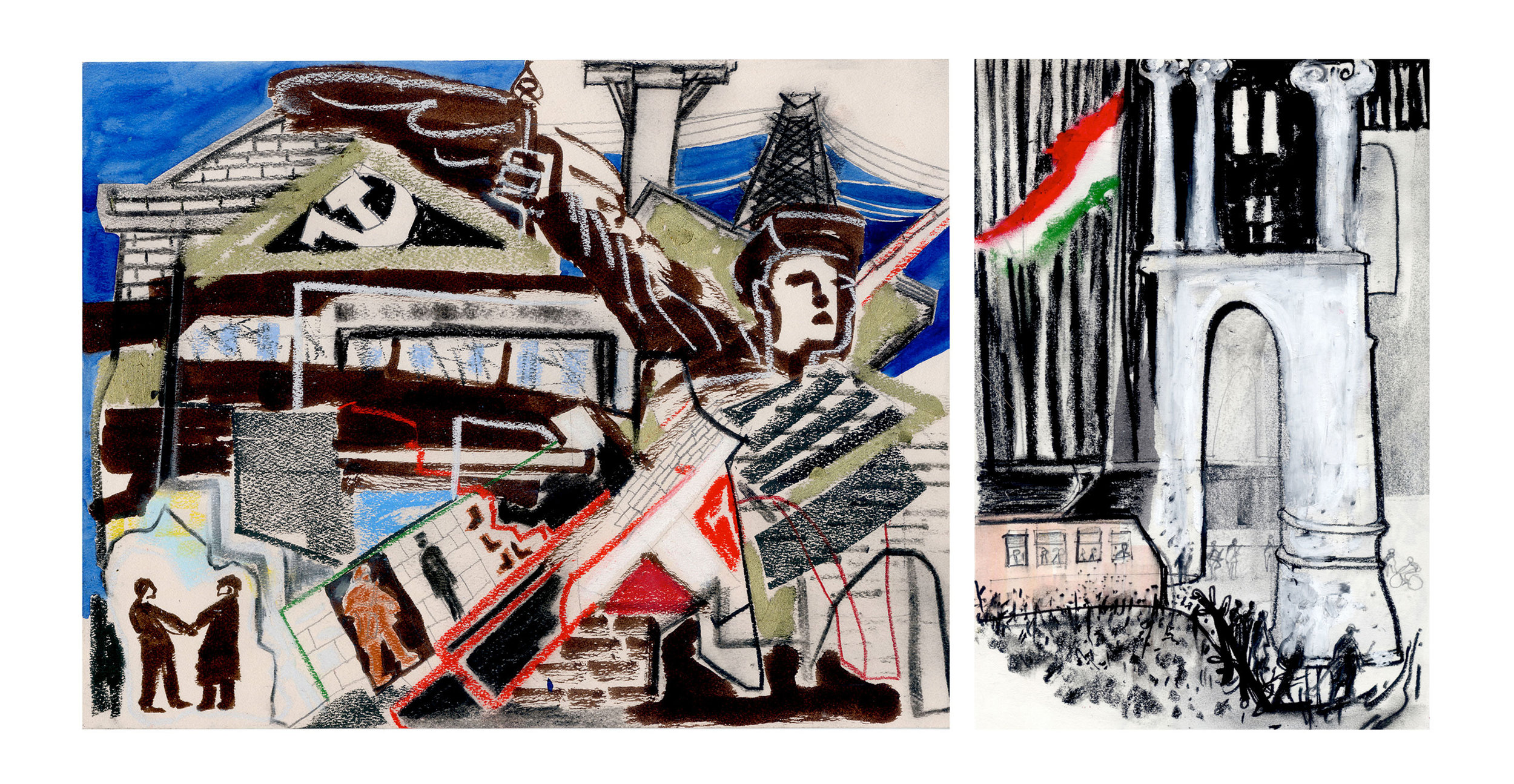I was so excited to visit Budapest, Hungary, a few weeks ago. I hadn't seen this part of Europe before and during the four days I was there, this city so impressed me with its unfussy beauty and seamless layering of so much history. Reaching back to the days of the Romans, Budapest absorbed culture after culture, one ambitious conqueror after another. It was like walking through a patchwork quilt narrating thousands of years of cultural absorption.
As I wandered the city, I noticed all the bridges crossing the Danube River ("Buda" and "Pest" were originally two places split by the river). They're all interesting as a kind of catalogue of various architectural styles, but I liked this simple modern one in contrast to the 19th Century buildings sprinkled around it.
There are also bits of Roman remains hanging around, like the remnants of this fortress wall:
My first official stop was Matyas (or Matthias) Church in the Castle Hill neighborhood. In my travel guidebook, this place looked like a castle from a Disney movie... and it pretty much did really look that way.
The church today gives a mainly Gothic impression, having been reconstructed in the 19th Century after damage, but the Baroque style Madonna statue tells the story of the church's original style. The Madonna, according to legend, was tucked away during the Turkish occupation (about 1580 - 1690), a secret hiding in the wall for centuries while the church was used as a mosque.
Surrounding Matyas are the walls of Fisherman's Bastion, newer in construction but referencing the medieval square where fish was sold and defensive walls deterred invasion. The statue is Saint Istvan, the king who accepted Christianity to Hungary around 1000 AD, before the Turkish invasion, and the turrets refer to the tribal tents of the original Magyar Hungarians.
A visiting American choir, the Young Women's Chorus of San Francisco, was rehearsing and I followed the melodies through the heavy wooden doors inside.
The space seemed to glow from the sound.
It was so moving that I went back that evening for their concert. They sang Bach, Hungarian folk songs, and American hymns - the international language of music!- and the audience of locals and tourists gave a standing ovation for these inspiring American voices.
No matter how many times I hear a choir I am always struck by how so many disparate voices can fit together so harmoniously. The sound was so vulnerably human, especially circling the walls of this ancient church, and maybe that was why it felt like an unearthly respite in my modern, digitally calculated day...
The next day was similarly humbling when I visited the Dohany Street Jewish synagogue.
Jews first came to the Buda side of the city in the 13th Century, and around 1800 were welcomed to the Pest side by the Habsburg (Enlightenment equality ideals-aware) ruler, Francis I.
Dohany Synagogue was built by a Christian architect in an effort to respectfully integrate with the dominantly Christian Hungarian society. The building still has an overall abstract design positioned to face Jerusalem.
Any gains in tolerant social coexistence were stamped out with the Nazis. The neighborhood surrounding Dohany was converted into a Jewish ghetto without food or heat; over 400,000 Hungarian Jews were deported to concentration camps.
This Tree of Life sculpture by Imre Varga, is made up of 6,000 steel weeping willow leaves, memorializing the 600,000 Hungarian Jews lost to the Holocaust. Behind it is a black granite tablet, echoing the 10 Commandments, but it stands blank since these sacred ethics were seemingly erased during this period in history.
When Soviets liberated the Jewish Ghetto in 1945, they found so many unidentifiable dead, a graveyard and memorial park was set up at Dohany so family and community members could have a place to commemorate.
For Hungary, Communism under Soviet rule followed WWII, which took me to my next stop in Budapest: Momento Park.
It was a kind of open air museum of Communist art and paraphernalia, recreating a sense of the years under Stalin and the Soviet regime. For decades following 1945, "Stalinism" took over Hungary - paranoia and the erasure of individual personality for the sake of the State. Bronze and stone statues depicting revolutionaries (Lenin), Soviet soldiers, and the diligent, obedient Hungarian worker perfectly illustrated the immobility of the time.
This modest little car was the only one available for a Hungarian to purchase. You had to pre-pay before it arrived 6-8 years later.
Attempts at resistance and change were suppressed, including a particularly brutal clash on October 25,1956, outside the present day Parliament building in Kossuth Square. A massive crowd had gathered outside to protest and Soviet tanks were present nearby. There are conflicting account about who first fired shots, but Soviet tanks began shooting into the unarmed crowd. Trapped by locked gates, there was no escape and the few survivors remembered "sidewalks painted red with blood."
Today there are two columns on the Department of Agriculture building sprayed with bullet holes, a record of the sacrifice.
It wasn't until 1989 that Hungary ousted the oppressive Communists and moved towards a free democratic state.
I needed a spirit lift by the time I left Momento park, and luckily there was a performance of local Hungarian folk dancing to bring me back to the colorful present. The performers were extraordinarily talented with no shortage of energy. Hungarian folk music is the epitome of resilience in rhythm (with very little use of slowing rubato and a unique habit of jumping up intervals of 4ths) and technical facility. The violinist was particularly energizing and seemed to have far more than 10 fingers!
The last day I went back over to the Parliament building, a symbol of Hungary's present Democracy. I kept thinking about the solidity of this building and all the clues of resilience it represented for Hungarians: architecture pointing to its ancient roots, a Soviet Star on the dome, a memorial for the 1956 uprising, the first permanent bridge linking Buda and Pest. Like the Danube River connecting these two pieces of land, Hungarians seem to take everything in stride, a continuous experiment in finding a balance between their traditions and a new way, the presence of Authority and the irrepressible individual spirit. Two sides stitched together, a try for fluid compromise, which any American will take comfort in seeing.












